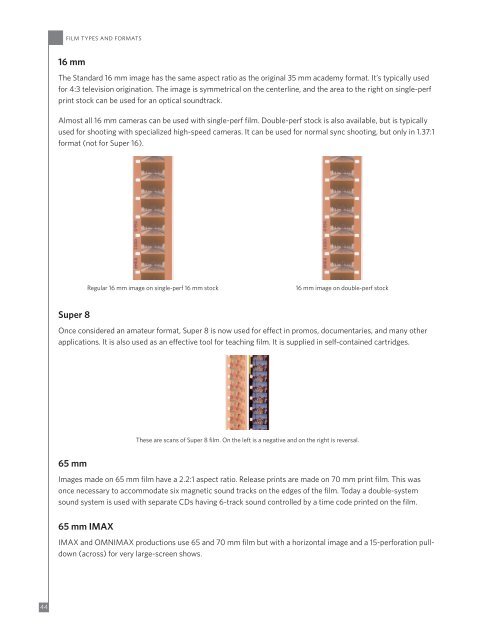You also want an ePaper? Increase the reach of your titles
YUMPU automatically turns print PDFs into web optimized ePapers that Google loves.
44<br />
<strong>FILM</strong> <strong>TYPES</strong> <strong>AND</strong> <strong>FORMATS</strong><br />
16 mm<br />
The Standard 16 mm image has the same aspect ratio as the original 35 mm academy format. It’s typically used<br />
for 4:3 television origination. The image is symmetrical on the centerline, and the area to the right on single-perf<br />
print stock can be used for an optical soundtrack.<br />
Almost all 16 mm cameras can be used with single-perf film. Double-perf stock is also available, but is typically<br />
used for shooting with specialized high-speed cameras. It can be used for normal sync shooting, but only in 1.37:1<br />
format (not for Super 16).<br />
Super 8<br />
Once considered an amateur format, Super 8 is now used for eect in promos, documentaries, and many other<br />
applications. It is also used as an eective tool for teaching film. It is supplied in self-contained cartridges.<br />
65 mm<br />
Regular 16 mm image on single-perf 16 mm stock 16 mm image on double-perf stock<br />
These are scans of Super 8 film. On the left is a negative and on the right is reversal.<br />
Images made on 65 mm film have a 2.2:1 aspect ratio. Release prints are made on 70 mm print film. This was<br />
once necessary to accommodate six magnetic sound tracks on the edges of the film. Today a double-system<br />
sound system is used with separate CDs having 6-track sound controlled by a time code printed on the film.<br />
65 mm IMAX<br />
IMAX and OMNIMAX productions use 65 and 70 mm film but with a horizontal image and a 15-perforation pulldown<br />
(across) for very large-screen shows.

















